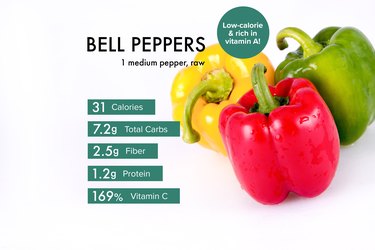
Crunchy, sweet bell peppers pack a punch of nutrients in every bite. These versatile veggies originated in South America and, because of their ability to adapt well to different climates, they were quickly cultivated and adopted into various cuisines worldwide.
Bell peppers are available in a range of colors — red, orange and yellow peppers are sweeter while green and purple peppers have a slightly bitter flavor. Red bell peppers are actually green peppers that have been allowed to ripen on the vine, making them sweeter. The widely-used spices paprika and pimento are both prepared from bell peppers.
Video of the Day
Video of the Day
Often thought to be a vegetable, bell peppers are technically fruits since they are produced from a flowering plant and contain seeds. Whatever you choose to call them, bell peppers are a smart and delicious way to get more nutrients.
Bell Pepper Nutrition Facts
One serving of bell peppers is 1 cup chopped, raw or cooked, or 1 medium raw bell pepper. One serving of bell peppers contains:
- Calories: 31
- Total fat: 0.4 g
- Cholesterol: 0 mg
- Sodium: 4.8 mg
- Total carbs: 7.2 g
- Dietary fiber: 2.5 g
- Sugar: 5 g
- Added sugar: 0 g
- Protein: 1.2 g
Bell Pepper Macros
- Total fat: One medium bell pepper has 0.4 grams of total fat, which includes 0.1 grams of saturated fat and 0 grams of trans fat.
- Carbohydrates: One medium bell pepper has 7.2 grams of carbs, which includes 2.5 grams of fiber and 5 grams of natural sugars.
- Protein: One medium bell pepper has 1.2 grams of protein.
Vitamins, Minerals and Other Micronutrients
- Vitamin C: 169% of your Daily Value (DV)
- Vitamin A: 21% DV
- Vitamin B6: 20% DV
- Folate (vitamin B9): 14% DV
- Vitamin B1: 5% DV
- Vitamin B2: 8% DV
- Vitamin B3: 7% DV
- Vitamin B5: 8% DV
- Vitamin E: 13% DV
- Vitamin K: 5% DV
- Potassium: 5% DV
- Manganese: 6% DV
Red Bell Pepper vs. Orange and Yellow Bell Pepper Nutrition
Per 100 g | Red Bell Pepper | Orange and Yellow Bell Pepper |
|---|---|---|
Calories | 26 | 27 |
Carbs | 6 g | 6 g |
Fiber | 2 g | 1 g |
Protein | 1 g | 1 g |
Vitamin C | 128 mg | 184 mg |
Vitamin A | 157 mcg | 10 mcg |
Beta-Carotene | 1624 mcg | 120 mcg |
Potassium | 211 mg | 212 mg |
The nutritional value of yellow peppers and orange peppers are the same. However, red bell peppers have significantly higher levels of vitamin A and beta-carotene than orange and yellow peppers because they are more pigmented.
There are 50 calories in an orange bell pepper (large) and just about 27 calories in a 100-gram (3.5-ounce) serving of pepper.
The Health Benefits of Bell Peppers
1. Bell Peppers Are a Vitamin C Powerhouse
Vitamin C serves many purposes throughout the human body and its most vital roles are related to its antioxidant capacity and nutrient synergy, according to a November 2017 article in Nutrients. Clocking in at 169 percent of our DV of C, one serving of bell pepper gets you more than your allotted amount of this fundamental vitamin.
Vitamin C acts as an antioxidant in the body, protecting against the negative effects of free radicals and protecting DNA, proteins and lipids from oxidative damage. Eating foods rich in vitamin C is associated with helping prevent and/or treat a range of health conditions, including heart disease, cancer and the common cold, according to the National Institutes of Health (NIH).
Another amazing benefit of vitamin C is its ability to help us absorb non-heme iron. Non-heme iron is found in plant foods, such as beans, lentils, leafy greens and whole grains. Humans cannot easily absorb non-heme iron and vitamin C acts synergistically to reduce the non-heme form from ferric to ferrous, which allows us to more easily absorb the nutrient, according to the October 2019 issue of Antioxidants.
This is particularly important for vegans and vegetarians who primarily eat non-heme iron versus the animal-based heme iron and are more likely to experience anemia.
2. Bell Peppers May Contribute to Healthy Eyesight
Bell peppers are an excellent source of vitamin A, in addition to a range of carotenoids, which are integral to eye health. Vitamin A is critical to our vision and is a major component of the protein rhodopsin, which supports the retina and cornea, according to the NIH. So much so that vitamin A deficiency may lead to blindness.
Many of us have heard that beta-carotene is good for our eyes. Bell peppers contain high levels of this vital vision carotenoid, which the body can convert into vitamin A. Carotenoids, which are yellow, red and orange pigments produced by plants, give bell peppers their hue.
Bell peppers also contain the carotenoids lutein and zeaxanthin, which protect the retina and are linked to a decreased risk of cataracts and macular degeneration as we age, per an April 2013 article in Nutrients.
3. Bell Peppers May Aid in Weight Loss
Bell peppers' combination of dietary fiber, low calories and high water content helps you to feel full for a longer period of time. It also allows you to add volume to your plate without adding extra calories.
Generally speaking, eating whole foods like bell peppers is preferable to processed and packaged foods, particularly when you're trying to lose weight.
The crunchy texture of bell peppers requires more chewing as well, which may slow down the rate at which you eat your meal. Eating slower and more mindfully allows your body to recognize when you are full and may help keep you from overeating.
Bell Pepper Health Risks
Food Allergies
Bell pepper is generally regarded as safe for most people to consume. There is a chance, however, that an individual with a pollen-related food allergy may be sensitive to bell peppers, according to an article in the May 2017 issue of Allergo Journal International.
The majority of IgE-mediated food allergies stem from sensitivity to pollen and show up in a variety of foods including apples, stone fruit, hazelnuts, soy, tomatoes and bell peppers. Many of these symptoms, however, are eliminated or reduced if the food is cooked, a process that breaks down the cell structure.
Another area of concern is the buzz around produce in the nightshade family and whether or not they increase inflammation in some people. Anecdotal case histories link improvement in arthritis when these are removed, however, there are no case-controlled scientific studies to confirm these observations.
Nightshades are a rich source of nutrients and benefit most diets, so be cautious when seeing unsubstantiated negative claims regarding these fruits and vegetables.
Green Peppers and IBS
Green peppers (but not red, yellow or orange peppers) are listed as one of the foods that cause gas, according to the International Foundation for Gastrointestinal Disorders. So if you have irritable bowel syndrome (IBS) or are prone to excess gas, you might want to pick a different pepper.
Drug Interactions
While bell peppers are not known to interact with any medications, be sure to discuss any food interactions with your medical professional.
How to Use Bell Peppers

Bell peppers are available throughout the year, but are generally more abundant during the summer months. Follow these tips to help pick and store your bell peppers:
- Pick bell peppers that are firm, fresh and bright in appearance.
- Avoid bell peppers that appear dry, have wrinkles or show signs of decay, such as water-soaked areas or injuries to the skin.
- Bell peppers should feel heavy for their size and be firm enough that they yield gently to slight pressure. (The shape of the bell pepper does not affect quality in any way.)
- Wash bell peppers thoroughly under cool running water prior to coring or cutting.
- Store unwashed bell peppers in the vegetable crisper drawer of the refrigerator; they should keep well for one week.
- Bell peppers can be frozen raw and whole; simply place in a resealable freezer-safe bag and store in the freezer for up to six months.
Bell peppers taste great raw or cooked and have an endless list of culinary possibilities. Enjoy them raw, grilled, roasted, sautéed and more. Here are some preparation ideas to get you started:
- Add chopped bell peppers to salads (including egg, tuna and chicken salads) and grain bowls for added flavor, nutrition and crunch.
- Add bell peppers to stir-fries, casseroles, soups, stews and chilis.
- Sliced and pair them with hummus or your favorite dip as a snack.
- Slice the top off and core a bell pepper, then steam or microwave it, stuff it with your favorite cooked whole grain and then bake at 350 degrees Fahrenheit for about 20 minutes. Add other toppings you enjoy like cheese and chopped veggies!
- Marinate large slices of bell pepper in olive oil, garlic, lemon juice, salt and pepper then roast in the oven at 425 degrees Fahrenheit for 20 minutes or cook on an outdoor grill or indoor grill pan.
- Fire-roasting bell peppers is also a good option. Place a whole bell pepper directly on a gas flame. Using tongs, turn occasionally and allow the skin to char and turn black. Place charred bell pepper in a paper bag or wrap with saran wrap and allow to steam and cool, about 15 to 20 minutes. Finally, place bell peppers under running water and peel off blistered skin.
Bell Pepper Recipes
Alternatives to Bell Pepper
Bell peppers of all colors can be used interchangeably in recipes. In place of bell peppers, vegetables such as celery and carrots can provide a similar texture in most dishes.
- CABI: "Capsicum annuum (bell pepper)"
- MyFoodData: "Bell Peppers"
- NIH: "Vitamin C and Immune Function"
- NIH: "Vitamin C Fact Sheet for Health Professionals"
- Antioxidants: "Vitamin C in Plants: From Functions to Biofortification"
- NIH: "Vitamin A Fact Sheet for Health Professionals"
- Nutrients: "Dietary Sources of Lutein and Zeaxanthin Carotenoids and Their Role in Eye Health"
- Allergo Journal International: "Pollen-related food allergy: an update"
- International Foundation for Gastrointestinal Disorders: "Tips on Controlling Gas"
- USDA: "Peppers, sweet, yellow, raw"